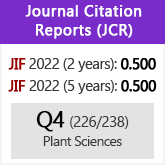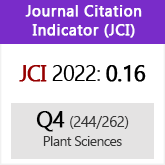Ecología y distribución de Senecio pterophorus (Compositae) en la Península Ibérica
DOI:
https://doi.org/10.3989/ajbm.2006.v63.i1.31Keywords:
diversity threat, habitat perturbation, introduced species, invasive species, morphologic plasticity, population structure, resource availabilityAbstract
Field survey in Catalonia (Spain) has increased the known distribution and the number of populations of the South African daisy Senecio pterophorus DC. in the Iberian Peninsula and mainland Europe. The species colonizes relatively disturbed habitats such as river beds, road borders and disturbed helm-oak communities with no limitation in light and water. The analysis of population structure related to habitat type has revealed that in riparian and ruderal areas populations are large and well-established, with a large number of members per age class. However, in disturbed forests populations have only a few scattered adults. Senecio pterophorus also shows great morphological plasticity related with habitat type: in open environments plants are shorter, adopt a spherical habit, and have smaller leaves than in forests, where they are taller and have leaves twice in size. This species may be considered as invasive in the Iberian Peninsula and mainland Europe, where it has rapidly spread in recent years. Furthermore, we suggest that S. pterophorus may be a threat to native species and habitat diversity as occurs in Australia, where the species displaces the native plants and hybridizes with some native Senecio species.
Downloads
References
Australian Weeds Committee. [2004]. Noxious Weed List for Australian States and territories. Version 10. [http://www.weeds.org.au/docs/weednet6.pdf].
Alpert, P., Bone, E. & Holzapfel, C. 2000. Invasiveness, invisibility and the role of environmental stress in the spread of non-native plants. Perspectives in Plant Ecology, Evolution and Systematics 3: 52-66. doi:10.1078/1433-8319-00004
Bolòs, O. de & Vigo, J. 1984. Flora dels Països Catalans, vol. I. Editorial Barcino. Barcelona.
Bond, P. & Goldblatt, P. 1984. Plants of the Cape Flora. A Descriptive Catalogue. Journal of South African Botany. Suppl. 13: 1-455.
Casasayas, T. 1989. La flora al.lòctona de Catalunya. Catàleg raonat de les plantes vasculars exòtiques que creixen sense cultiu al NE de la Península Ibèrica. Tesis doctoral. Universitat de Barcelona.
C.E.C. 1991. Commission of the European Communities– CORINE biotopes manual. Habitats of the European Community. EUR 12587/3. Office for Official Publications of the European Communities. Luxembourg.
D’Antonio, C.M. 1993. Mechanisms controlling invasion of coastal plant communities by the alien succulent Carpobrotus edulis. Ecology 74: 83-95. doi:10.2307/1939503
Davis, M.A. & Pelsor, M. 2001. Experimental support for a resource- based mechanistic model of invasibility. Ecology letters 4: 421-428. doi:10.1046/j.1461-0248.2001.00246.x
Davis, M.A. & Thompson, K. 2000. Eight ways to be an invader: a proposed nomenclature scheme for invasion ecology. Bulletin of the Ecological Society of America 81: 226-230.
Davis, M. Grime, J. & Thompson, K. 2000. Fluctuating resources in plant communities: a general theory of invasibility. Journal of Ecology 88: 528-534. doi:10.1046/j.1365-2745.2000.00473.x
D.M.A.H. [2005]. Llista d’Hàbitats de Catalunya. Departament de Medi Ambient i Habitatge-Generalitat de Catalunya.
Department of Primary Industries 2000 [consulted web 2004]. African daisy. Landcare Notes LC0196 [LC0196.pdf, online ISSN 1329-833X].
Fox, M.D. 1990. Mediterranean weeds: exchanges of invasive plants between the five Mediterranean regions of the world. In: Di Castri, F. & al. (eds.), Biological invasions in Europe and the Mediterranean basin. Kluwer Academic Publishers. Dordrecht.
Garcia-Serrano, H. 2004. Comparative studies of alien and native Senecio species differing in invasiveness and distribution range. PhD Thesis. Universitat de Barcelona.
Garcia-Serrano, H., Escarré, J. & Sans, F.X. 2004. Factors that limit the emergence and establishment of the related aliens Senecio inaequidens and S. pterophorus and the native S. malacitanus in Mediterranean climate. Canadian Journal of Botany 82: 1346-1355. doi:10.1139/b04-097
Garcia-Serrano, H., Sans, F.X., Escarré, J. & Garnier, E. 2005. A comparative growth analysis between alien and native Senecio species with distinct distribution range. Ecoscience 12(1): 35-43. doi:10.2980/i1195-6860-12-1-35.1
Harrison, P.G. 1996. Seed import-Brief guidelines. Revised by Australian Quarantine Inspection Service. Agnote 135: 1-5.
Lambrinos, J.G. 2000. The impact of the invasive alien grass Cortaderia jubata (Lemoine) Stapf on an endangered mediterranean- type shrubland in California. Diversity and Distributions 6: 217-231. doi:10.1046/j.1472-4642.2000.00086.x
Lawrence, M.E. 1985. Senecio L. (Asteraceae) in Australia: Reproductive Biology of a genus found in unstable environment. Austalian Journal of Botany 33: 197-208. doi:10.1071/BT9850197
Plants Biosecurity New Zealand. 2002. Ministry of Agriculture and Forestry Biosecurity Authority. Standard 155.02.05. Importation of seeds for sowing. Ministry of Agriculture and Forestry. Wellington, New Zeland.
Mack, R.N., Simberloff, D., Lonsdle, W.M., Evans, H., Clout, M. & Bazzaz, F.A. 2000. Biotic invasions: Causes, epidemiology, global consequences and control. Applied Ecology 10: 689-710. doi:10.1890/1051-0761(2000)010[0689:BICEGC]2.0.CO;2
Parsons, W.T. & Cuthbertson, E.G. 1992. Noxious Weeds of Australia. Inkata Press. Melbourne & Sidney.
Pino, J. 2001. Senecio pterophorus DC., una nova espècie vegetal per al Baix Llobregat. Spartina. Butlletí Naturalista del Delta del Llobregat, 4: 108.
Pino, J., Afán, I., Sans, F.X. & Gutiérrez, C. 2000. Senecio pterophorus D.C., a new alien species in the European mainland. Anales del Jardín Botánico de Madrid 58: 188-89.
Prieur-Richard, A.-H. 1999. Les communautés végétales plus diverses sont-elles plus résistantes aux invasions? Une approche expérimentale dans les friches méditerranéennes. Thèse de Doctorat. Université de Montpellier II, Sciences et Techniques du Languedoc.
Roy, J. 1990. In search of characteristics of plant invaders. In: Di Castri, F., Hansen A.J. & Debussche M. (eds.), Biological invasions in Europe and the Mediterranean Basin: 335-352. Kluwer Academic Publishers. Dordrecht.
Sans, F.X., Garcia-Serrano, H. & Afán, I. 2004. Life history traits of alien and native Senecio species in the Mediterranean region. Acta Oecologica 26: 167-178. doi:10.1016/j.actao.2004.04.001
Sokal, R. R. & Rohlf, F. J. 1989. Biometry. The principles and practice of statistics in biological research. Freeman and Co. New York.
Stace, C. 1997. New flora of the British Isles. 2nd ed. Cambridge University Press. Cambridge.
Thébaud, C. & Debussche, M. 1991. Rapid invasion of Fraxinus ornus L. along the Herault River System in southern France: the importance of seed dispersal by water. Journal of Biogeography 18(1): 7-12. doi:10.2307/2845240
Tilman, D. & Lehman, C. 2001. Human caused environmental change: Impacts on plant diversity and evolution. Proceedings of the National Academy of Siences of the USA 98: 5433- 5440. doi:10.1073/pnas.091093198
Tucker, P. [2004] South African daisy-Senecio pterophorus. Bushland Weeds in South Australia.
Vitousek, P.M., D’Antonio, C.M., Loope, L.L., Rejmanek, M.& Westbrooks, R. 1997. Introduced species: a significant component of human causes global change. New Zealand Journal of Ecology 21(1): 1-16.
Wells, M.J., Balsinhas, A.A., Joffe, H., Engelbrecht, V.M., Harding, G. & Stirton, C.H. 1986. A catalogue of problem plants in southern Africa. Memoirs of the Botanical Survey of South Africa 53: 471.
Williamson, M. & Fitter, A. 1996. The varying success of invaders. Ecology 77: 1661-1666. doi:10.2307/2265769
Downloads
Published
How to Cite
Issue
Section
License
Copyright (c) 2006 Consejo Superior de Investigaciones Científicas (CSIC)

This work is licensed under a Creative Commons Attribution 4.0 International License.
© CSIC. Manuscripts published in both the printed and online versions of this Journal are the property of Consejo Superior de Investigaciones Científicas, and quoting this source is a requirement for any partial or full reproduction.All contents of this electronic edition, except where otherwise noted, are distributed under a “Creative Commons Attribution 4.0 International” (CC BY 4.0) License. You may read here the basic information and the legal text of the license. The indication of the CC BY 4.0 License must be expressly stated in this way when necessary.
Self-archiving in repositories, personal webpages or similar, of any version other than the published by the Editor, is not allowed.

















